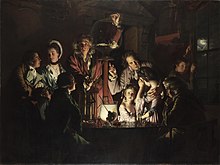An Experiment with an Air Pump
| An Experiment with an Air Pump | |
|---|---|

An Experiment on a Bird in the Air Pump by Joseph Wright of Derby, 1768
|
|
| Written by | Shelagh Stephenson |
| Characters | Joseph Fenwick Susannah Fenwick Harriet Fenwick Maria Fenwick Peter Mark Roget Thomas Armstrong Isobel Bridie Ellen Tom Phil Kate |
| Date premiered | 12 February 1998 |
| Original language | English |
| Subject | Science & Morality |
| Genre | Drama |
| Setting | A house in Newcastle-Upon-Tyne in 1799 & 1999. |
| Official site | |
An Experiment with an Air Pump is a play by British playwright Shelagh Stephenson inspired by the painting An Experiment on a Bird in the Air Pump by Joseph Wright. It shared the Peggy Ramsay Award for 1997, was first performed at the Royal Exchange Theatre, Manchester in 1998, and has since been staged by a number of other companies worldwide. It was published in Plays One, a collection of Stephenson's plays published in 2002.
The plot takes place in the same house in two different time periods divided by the gap of two hundred years (1799 and 1999). The play questions the basic principles of scientific (medical) research, such as the right of the scientist to cross ethical limits: the right to perform dissection on the recently deceased (1799) and use of embryos in stem-cell research (1999).
Both years are symbolic—they stand at the turns of new centuries and have to face the challenges the new times are about to bring. There will be a great development in medicine in the 19th and of genetics in the 21st centuries.
The play also implicitly deals with gender roles and questions the stereotypes of women scientists. While in 1799, it is the father (Fenwick) who is the enlightened soul and his male friends are also scientists (Armstrong, the physician, and Roget, the to-be-author of the thesaurus), his wife (Susannah) is a stereotypical wife of the time and their two daughters (Maria and Harriet) are expected to be such, too. The decision of one of them to become a scientist leads to disapproval. In 1999, the roles somehow change: Ellen, the wife, is the geneticist, and her husband, Tom, is a historian. Ellen's friend, Kate, is also a young genetic researcher. There are also two "uneducated" characters: Isobel, the 1799 maid, and Phil, the 1999 handyman.
An additional theme of this play involves the ethics of using human life, in any form, for the advancement of science. Though the topic is not specifically discussed in 1799, the characters in 1999 do talk about the issue, though no concrete conclusions are drawn.
Besides the general questions about a scientist's responsibilities and limits, the play is in part a detective story. In the modern times, a skeleton is found in the basement. The skipping between the two time periods highlights, then resolves, questions about the identity of the corpse and the means of their death.
After Armstrong seduces Isobel, he confesses to Roget that he feigned love for Isobel because then she would agree to have intercourse with him. If she is naked, then he can examine her twisted spine more thoroughly. Isobel overhears and is moved to kill herself by hanging. Armstrong finds her hanging and speeds up the process. The characters in 1799 ring in the new year with the death of Isobel, whereas, the characters in 1999 begin the new millennium leaving their old home, and the certainties it possessed for them, behind.
...
Wikipedia
